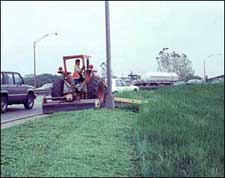















Successes in Stewardship: April 2004 |
|---|

|
Federal Highway Administration
April 2004
Back to Basics: Maintenance & Operations Activities Improving Environmental Performance
In the past, State Departments of Transportation (DOTs) mainly focused on environmental compliance in setting environmental stewardship priorities. However, in recent years, DOTs have been placing new emphasis on operations and maintenance planning. Incorporating environmental stewardship goals into operations and maintenance activities helps DOTs achieve continuous improvement in environmental performance. Many have developed successful programs with components such as plans for integrated roadside vegetation management, salt reduction, and water quality improvement; overarching environmental management systems; and the addition of environmental specialists to the traditional mix of maintenance and construction staff. Many of these stewardship initiatives have also provided streamlining benefits.
 |
Featured Best Practices in Maintenance and Operations
|
Roadside rights-of-way account for more than 10 million acres of land in the United States. Over the years, the standard for roadside management has evolved from simple slope stabilization to holistic roadside vegetation programs that economically manage roadsides for safety, environmental health, and visual quality. An Integrated Roadside Vegetation Management (IRVM) Plan is a decision-making and quality-management process that integrates cultural, biological, mechanical, and chemical vegetation management methods. IRVM plans offer many environmental benefits, including: improved water and air quality, protected soil, increased biodiversity and desirable native plant communities, reduced number of invasive plants and weeds, and improved safety for wildlife. Some DOTs have used IRVM to develop more flexible and cost-effective approaches. As part of their IRVM plans, DOTs in Iowa, Minnesota, Wisconsin, and New York have implemented mowing reductions that conserve resources and benefit native species. Utah's IRVM includes an extensive training program and vegetation inventories via GIS. Iowa extended its landmark IRVM program to revegetate over 2,200 acres of non-native roadside with native grasses and forbs last year, in addition to the over 3,000 acres of native grasses and wildflowers seeded as part of construction projects.
The effects of salt on the natural environment are also of increasing concern to State DOTs and their stakeholders. A number of DOTs are investigating and implementing ways to reduce salt usage on roadways and to better manage salt at its facilities. New York State DOT trains staff in salt management reduction techniques and has documented usage reductions over several seasons. Some DOT maintenance sections have reduced salt usage through the increased use of anti-icing chemicals, which prevent the ice bond from developing in the first place, and with precision timing of material application. Achieving the benefits of salt reduction requires close monitoring of material usage, regular calibration of equipment, and new training programs. Precise application rates often rely on real-time data, including weather forecasts, road friction measurements, and road surface temperature measurements, provided by sensor-based information systems such as environmental monitoring and global positioning equipment. As this technology evolves, considerable planning, training, organization, and evaluation are required to ensure its best use.
Water quality management has become a high-profile issue for many State DOTs as eroded material and other pollutants generated by operation and maintenance of highway facilities affect water resources. Over the past few years a number of States have developed best management practices bulletins (California) and manuals (Kentucky, North Carolina, and New York), or measures to improve erosion control in maintenance (Pennsylvania). The Pennsylvania DOT estimated that an erosion control incident or containment measure failure costs approximately 76 staff hours, or approximately $2,600 dollars to fix, making proactive planning worth the cost. Other States have taken water quality management a step further by developing water quality management and stormwater facility retrofit plans. The Maryland State Highway Administration has implemented a very structured improvement program for stormwater facilities, with trained inspection teams that evaluate existing facilities and identify further environmental improvements that can be made. Washington State DOT's Environmental Retrofit Program aims "to retrofit State highway facilities as appropriate to reduce existing environmental impacts," a commitment made in addition to performing appropriate avoidance, minimization, and environmental mitigation as a part of all other highway system projects.
An increasing number of states are investigating and applying environmental management systems (EMS) — a quality-improvement-and-assurance process that promotes planning, well-documented action, re-evaluation, and implementation of improvements through revisions of plans and procedures. As DOTs update their environmental-performance approaches from project-by-project methods to agency-wide efforts, EMS provide valuable tools for incorporating best practices into new ways of doing business and for increasing staff buy-in and commitment. Thus far, EMS have been used to target improvements to waste streams and maintenance facilities/depots in Massachusetts and Maine, traffic bureau and painting operations in New Hampshire, salt storage and maintenance erosion control in Pennsylvania, and ferry system operations in Maine.
Several State DOTs have added environmental staff to assist maintenance staff in meeting environmental goals and implementing planned improvements. New York and Virginia DOTs provide the most far-reaching and staff-rich models. Virginia has placed 29 environmental staff in residence around the state, primarily to support maintenance operations. Another 19 environmental personnel monitors serve as erosion and sedimentation control experts around Virginia, monitoring the full range of environmental commitments. New York has placed 22 senior environmental specialists around the state, 11 to support construction and 11 to support maintenance. These specialists enhance communication as well as provide training, oversight, quality assurance, and technical advice. They spend approximately 50 percent of their time in the field working directly with maintenance and construction staff developing new beneficial practices and promoting hands-on environmental stewardship.
Why Focus on Maintenance and Operations?Maintenance and operations activities encompass all areas of a highway system. So improvements in these areas, even seemingly minor ones, can have far-reaching impacts.
|
Ruth Rentch |
|
"Successes in Stewardship" is a Federal Highway Administration newsletter highlighting current environmental streamlining practices from around the country. To subscribe, call (617) 494-6352 or email esnewsletter@volpe.dot.gov.

|